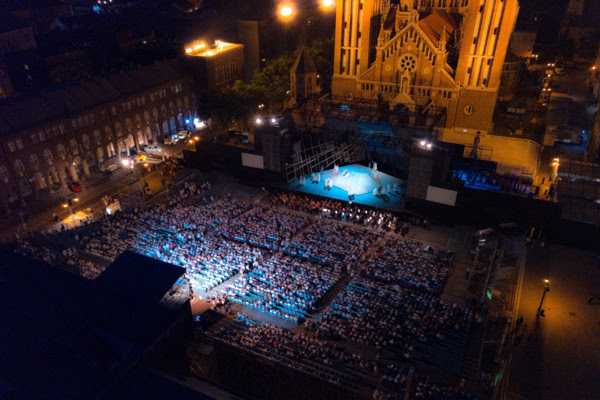TiMax immersive sound enhances Aida
- Details

This year’s futuristic treatment of Aida, where love is set against the backdrop of war, marked the 80th anniversary since the eponymous opera’s first 1939 staging at this striking venue. Complementing director Gergely Kesselyak’s use of high-tech LED and multimedia scenography, TiMax SoundHub with HARDCore FPGA spatial processing added a new level of vocal and orchestral sonic immersion to an audience of 8000 over two nights.
Hungarian TiMax specialists Votec have managed the event’s audio for several years, but Votec international business manager, Otari Tsereteli, revealed, “For the first time we were able to create a natural and immersive sound here at the Szeged Open-Air theatre together with TiMax.”
Votec deployed TiMax SoundHub with their own proprietary loudspeaker brand ES Audio; Otari continues, “The audience heard the opera like never before. Every sound - music - voice came from the direction of where it physically was on stage. It felt real! Though, incredibly, some people thought the speakers were turned off.”
TiMax dynamic vocal localisation was controlled in real-time by all-new TiMax TrackerD4 precision stagetracking, employing seven TTd4 Sensors, with five mounted above the stage at the front, sides and upstage, plus a pair downstage at stage level. Twelve principals and four choir group leaders wore miniature TTd4 Tags which transmitted their identities to the network of Sensors via a quick-fire stream of radar-frequency UWB chirps.
Mic channel direct-outs and eight orchestra groups were sent to TiMax from an Avid S6L console via MADI, with vocal mics pre-amped and balanced on a classic Midas XL4 console feeding the S6L.
Sound engineers were Votec's Lajos Pánczélon, balancing vocals from the opera singers and choirs, whilst the orchestra was handled by Werner Schmidl, Szeged Sabadteri’s veteran guest engineer who was flown in specially from Germany for the festival.
Votec’s ES Audio loudspeakers feature bespoke HF ribbon drivers incorporated into efficient and versatile 3-way and 2-way large-format and compact line array configurations. All speaker channels were fed from separate TiMax outputs, via Powersoft amps. The distributed spatial audio system, designed by Votec's Sandor Elek and Dave Haydon from TiMax developers Out Board, featured ESA126 main left and right large-format line array hangs plus three spaced out centre hangs of NJ66FLA, splayed outwards to fire in audience-left -centre and -right directions. Six pairs of NJ66 were distributed as front-fills along the front of the audience.
Ten metres upstage three more NJ66FLA drops were similarly spaced but cross-fired as “anchors” to support upstage imaging for the frontal flown systems' TiMax spatial reinforcement. An additional 10 hangs of NJ66FLA surrounded the audience seating to deliver convincing immersive concert-hall surround reverb. Three TC6000 reverb engines were spatialised and time-mapped in TiMax Image Definitions.
TiMax PanSpace mapped forty-nine vocal imaging zone objects across the 40sq.m stage, and eight spatial zones across in front of the stage for the orchestra.
Out Board’s Dave Haydon was on site to assist with TiMax setup and programming, alongside Votec's Otari Tsereteli and system engineer Mark Zsibok, who managed TiMax during rehearsals and for the show. Haydon observed “It was great to see and hear our tailored spatial reinforcement system design work as well as intended - the throw and coverage of the compact ES Audio arrays were phenomenal, especially for such small boxes, and their ribbon drivers’ coherence really seemed to help in blending the TiMax spatialisation together so seamlessly.”
(Jim Evans)
















